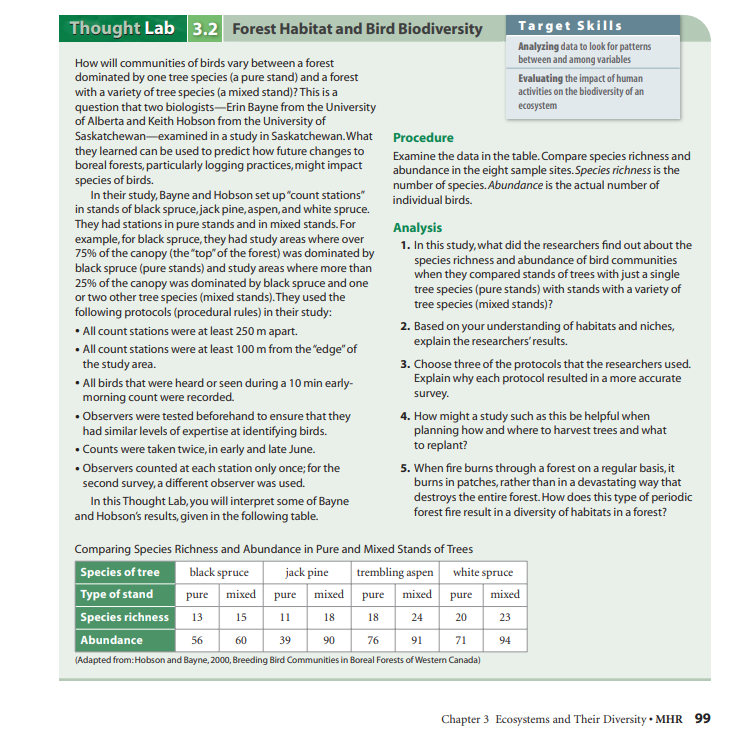What did the results of the study show? What techniques did the researchers use in the study to increase the accuracy of their study? How do periodic fires result in more diversity in a forest?
What did the results of the study show? What techniques did the researchers use in the study to increase the accuracy of their study? How do periodic fires result in more diversity in a forest?
Biology (MindTap Course List)
11th Edition
ISBN:9781337392938
Author:Eldra Solomon, Charles Martin, Diana W. Martin, Linda R. Berg
Publisher:Eldra Solomon, Charles Martin, Diana W. Martin, Linda R. Berg
Chapter55: Ecosystems And The Biosphere
Section: Chapter Questions
Problem 18TYU: INTERTRET DATA Scientists have compiled databases of large forest wildfires in the western United...
Related questions
Question
Refer to Thought Lab 3.2 on page 99 of the textbook to complete the questions
- What did the results of the study show?
- What techniques did the researchers use in the study to increase the accuracy of their study?
- How do periodic fires result in more diversity in a forest?

Transcribed Image Text:Thought Lab 3.2 Forest Habitat and Bird Biodiversity
How will communities of birds vary between a forest
dominated by one tree species (a pure stand) and a forest
with a variety of tree species (a mixed stand)? This is a
question that two biologists-Erin Bayne from the University
of Alberta and Keith Hobson from the University of
Saskatchewan-examined in a study in Saskatchewan. What
they learned can be used to predict how future changes to
boreal forests, particularly logging practices, might impact
species of birds.
In their study, Bayne and Hobson set up "count stations"
in stands of black spruce, jack pine, aspen, and white spruce.
They had stations in pure stands and in mixed stands. For
example, for black spruce, they had study areas where over
75% of the canopy (the "top" of the forest) was dominated by
black spruce (pure stands) and study areas where more than
25% of the canopy was dominated by black spruce and one
or two other tree species (mixed stands). They used the
following protocols (procedural rules) in their study:
• All count stations were at least 250 m apart.
• All count stations were at least 100 m from the "edge" of
the study area.
• All birds that were heard or seen during a 10 min early-
morning count were recorded.
• Observers were tested beforehand to ensure that they
had similar levels of expertise at identifying birds.
• Counts were taken twice, in early and late June.
• Observers counted at each station only once; for the
second survey, a different observer was used.
In this Thought Lab, you will interpret some of Bayne
and Hobson's results, given in the following table.
pure mixed
Target Skills
Analyzing data to look for patterns
between and among variables
Evaluating the impact of human
activities on the biodiversity of an
ecosystem
90
Procedure
Examine the data in the table. Compare species richness and
abundance in the eight sample sites. Species richness is the
number of species. Abundance is the actual number of
individual birds.
Analysis
1. In this study, what did the researchers find out about the
species richness and abundance of bird communities
when they compared stands of trees with just a single
tree species (pure stands) with stands with a variety of
tree species (mixed stands)?
2. Based on your understanding of habitats and niches,
explain the researchers' results.
3. Choose three of the protocols that the researchers used.
Explain why each protocol resulted in a more accurate
survey.
4. How might a study such as this be helpful when
planning how and where to harvest trees and what
to replant?
Comparing Species Richness and Abundance in Pure and Mixed Stands of Trees
Species of tree
Type of stand
black spruce
trembling aspen white spruce
jack pine
pure mixed
11
pure
mixed pure
mixed
J
Species richness
13 15
18
24
23
Abundance
56
60
39
76
91
71
94
(Adapted from: Hobson and Bayne, 2000, Breeding Bird Communities in Boreal Forests of Western Canada)
5. When fire burns through a forest on a regular basis, it
burns in patches, rather than in a devastating way that
destroys the entire forest. How does this type of periodic
forest fire result in a diversity of habitats in a forest?
Chapter 3 Ecosystems and Their Diversity MHR 99
Expert Solution
This question has been solved!
Explore an expertly crafted, step-by-step solution for a thorough understanding of key concepts.
Step by step
Solved in 5 steps

Knowledge Booster
Learn more about
Need a deep-dive on the concept behind this application? Look no further. Learn more about this topic, biology and related others by exploring similar questions and additional content below.Recommended textbooks for you

Biology (MindTap Course List)
Biology
ISBN:
9781337392938
Author:
Eldra Solomon, Charles Martin, Diana W. Martin, Linda R. Berg
Publisher:
Cengage Learning

Biology: The Unity and Diversity of Life (MindTap…
Biology
ISBN:
9781337408332
Author:
Cecie Starr, Ralph Taggart, Christine Evers, Lisa Starr
Publisher:
Cengage Learning

Biology: The Dynamic Science (MindTap Course List)
Biology
ISBN:
9781305389892
Author:
Peter J. Russell, Paul E. Hertz, Beverly McMillan
Publisher:
Cengage Learning

Biology (MindTap Course List)
Biology
ISBN:
9781337392938
Author:
Eldra Solomon, Charles Martin, Diana W. Martin, Linda R. Berg
Publisher:
Cengage Learning

Biology: The Unity and Diversity of Life (MindTap…
Biology
ISBN:
9781337408332
Author:
Cecie Starr, Ralph Taggart, Christine Evers, Lisa Starr
Publisher:
Cengage Learning

Biology: The Dynamic Science (MindTap Course List)
Biology
ISBN:
9781305389892
Author:
Peter J. Russell, Paul E. Hertz, Beverly McMillan
Publisher:
Cengage Learning

Biology 2e
Biology
ISBN:
9781947172517
Author:
Matthew Douglas, Jung Choi, Mary Ann Clark
Publisher:
OpenStax